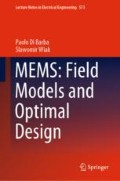Abstract
Electrostatic micromotors were the first MEMS which had been designed and prototyped exploiting Silicon integrated technology.
Access this chapter
Tax calculation will be finalised at checkout
Purchases are for personal use only
References
Bart SF, Mehregany M, Tavrow LS, Lang JH, Senturia SD (1992) Electric micromotor dynamics. IEEE Trans Electron Devices 39(3)
Chereches R, Di Barba P, Topa V, Purcar M, Wiak S (2013) Optimal shape design of electrostatic microactuators: a multiobjective formulation. Int J Appl Electromagn Mech IJAEM 43(1–2):65–76
Chereches RL, Di Barba P, Wiak S (2015) Non-linear inverse problems and optimal design of MEMS. COMPEL—Int J Comput Math Electr Electron Eng 34(3):608–623
Delinchant B, Rakotoarison HL, Ardon V, Chabedec O, Cugat O (2009) Gradient based optimization of semi-numerical models with symbolic sensitivity: application to simple ferromagnetic MEMS switch device. Int J Appl Electromagn Mech IJAEM 30:189–200
Di Barba P, Liu B, Mognaschi ME, Venini P, Wiak S (2017) Multiphysics field analysis and evolutionary optimization: design of an electro-thermoelastic microactuator. Int J Appl Electromagn Mech 54(3):433–448
Di Barba P, Dughiero F, Mognaschi ME, Savini A, Wiak S (2016) Biogeography-inspired multiobjective optimization and MEMS design. IEEE Trans Magn 52(3)
Di Barba P, Gotszalk T, Majstrzyk W, Mognaschi ME, Orłowska K, Wiak S, Sierakowski A (2018) Optimal design of electromagnetically actuated MEMS cantilevers. Sensors (Switzerland) 18(8)
Di Barba P, Mognaschi ME, Savini A, Wiak S (2016) Island biogeography as a paradigm for MEMS optimal design. Int J Appl Electromagn Mech IJAEM 51(s1):97–105
Di Barba P, Mognaschi ME, Venini P, Wiak S (2017) Biogeography-inspired multiobjective optimization for helping MEMS synthesis. Arch Electr Eng 66(3):607–623
Di Barba P, Savini A, Wiak S (1994) 2-D numerical simulation of electrostatic micromotor torque. In: Proceedings of the second international conference on computation in electromagnetics, Nottingham, pp 227–230
Di Barba P, Savini A, Wiak S (2008) Field models in electricity and magnetism. Springer, Berlin
Di Barba P, Savini A, Wiak S (2017) Higher-order multiobjective design of MEMS. Int J Appl Electromagn Mech 53(S2):S239–S247
Di Barba P, Wiak S (2015) Evolutionary computing and optimal design of MEMS. IEEE/ASME Trans Mechatron 20(4):1660–1667
Fan LS, Tai YC, Muller R (1989) IC processed electrostatic microactuator’s. Sens Actuators 20:41–47
Fan LS, Tai YC, Muller R (1989) IC processed electrostatic synchronous microactuators. Sens Actuators 20:49–55
Guckel H (1998) Progress in magnetic microactuators. Microsyst Technol 5(2):59–61
Guckel H, Earles T, Klein J, Zook JD, Ohnstein T (1996) Electromagnetic linear actuators with inductive position sensing. Sens Actuators A 53:386–391
Huang QA, Lee NKS (1999) Analytical modeling and optimization for a laterally-driven polysilicon thermal actuator. Microsyst Technol 5:133–137
Hussein H, Tahhan A, Le Moal P, Bourbon, G, Haddab Y, Lutz P (2016) Dynamic electro-thermo-mechanical modelling of a U-shaped electro-thermal actuator. J Micromech Microeng 26(2)
Kolesar ES, Allen PB, Howard JT, Wilken JM, Boydston N (1999) Thermally actuated cantilever beam for achieving large in-plane mechanical deflections. Thin Solid Films 355:295–302
Legtenberg R, Groeneveld AW, Elwenspoek M (1996) Comb-drive actuators for large displacements. J Micromech Microeng 6:320–329
Majstrzyk W, Mognaschi ME, Orłowska K, Di Barba P, Sierakowski A, Dobrowolski R, Grabiec P, Gotszalk T (2018) Electromagnetic cantilever reference for the calibration of optical nanodisplacement systems. Sens Actuators A 282:149–156
Mehregany M, Senturia SD, Lang JH, Nagarkar P (1992) Micromotor fabrication. IEEE Trans Electron Devices 39:2060–2069
Paratte L, Racine GA, De Rooij NF, Bornand E (1991) Design of an integrated electrostatic stepper motor with axial field. Sens Actuators A 25–27:597–603
Senturia SD, Harris RM, Johnson BP, Nabors SK, Shulman MA, White JK (1992) A computer-aided design system for microelectromechanical systems (MEMCAD). J Microelectromech Syst 1:3–13
Tang WC, Lim MG, Howe RT (1992) Electrostatic comb drive levitation and control method. J Microelectromech Syst 1:170–178
Wiak S, Smołka K (2009) Numerical modelling of 3-D comb drive electrostatic accelerometers structure (method of levitation force reduction). COMPEL 28:593–602
Author information
Authors and Affiliations
Corresponding author
Rights and permissions
Copyright information
© 2020 Springer Nature Switzerland AG
About this chapter
Cite this chapter
Di Barba, P., Mognaschi, M.E. (2020). Numerical Case Studies: Forward Problems. In: MEMS: Field Models and Optimal Design. Lecture Notes in Electrical Engineering, vol 573 . Springer, Cham. https://doi.org/10.1007/978-3-030-21496-8_13
Download citation
DOI: https://doi.org/10.1007/978-3-030-21496-8_13
Published:
Publisher Name: Springer, Cham
Print ISBN: 978-3-030-21495-1
Online ISBN: 978-3-030-21496-8
eBook Packages: EngineeringEngineering (R0)

